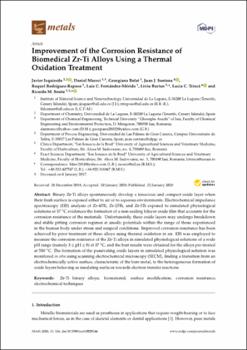Improvement of the corrosion resistance of biomedical Zr-Ti alloys using a thermal oxidation treatment
Date
2020Abstract
Binary Zr-Ti alloys spontaneously develop a tenacious and compact oxide layer when
their fresh surface is exposed either to air or to aqueous environments. Electrochemical impedance
spectroscopy (EIS) analysis of Zr-45Ti, Zr-25Ti, and Zr-5Ti exposed to simulated physiological
solutions at 37 C evidences the formation of a non-sealing bilayer oxide film that accounts for the
corrosion resistance of the materials. Unfortunately, these oxide layers may undergo breakdown
and stable pitting corrosion regimes at anodic potentials within the range of those experienced
in the human body under stress and surgical conditions. Improved corrosion resistance has been
achieved by prior treatment of these alloys using thermal oxidation in air. EIS was employed to
measure the corrosion resistance of the Zr-Ti alloys in simulated physiological solutions of a wide
pH range (namely 3 pH 8) at 37 C, and the best results were obtained for the alloys pre-treated
at 500 C. The formation of the passivating oxide layers in simulated physiological solution was
monitored in situ using scanning electrochemical microscopy (SECM), finding a transition from an
electrochemically active surface, characteristic of the bare metal, to the heterogeneous formation of
oxide layers behaving as insulating surfaces towards electron transfer reactions.






